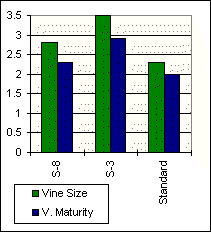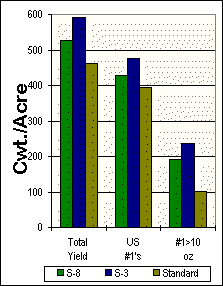Higher yielding Russet Norkotahs with larger, more vigorous vines, have greater resistance to heat, hail and disease. Potato growers who like Russet Norkotahs for their long tuber type, shallow eyes and high percentage of US #1s, but dislike growing them because of their above average input requirements for nitrogen, water and fungicides, now have a better alternative. The Potato Breeding and Selection Program at Colorado State University has developed two new Russet Norkotah selections, Selection 3 and Selection 8, that have larger more vigorous vines than the standard Norkotah, resulting in higher yields and better resiliency during the growing season.
| 1997 Western Regional Trials
Standard R. Norkotah vs. Selections 3 & 8 Vine size and Maturity |
1997 Western Regional Trials
Standard R. Norkotah vs. Selections 3 & 8 Mean Yield Comparison |
 |
 |
These new lines are the result of research and selection initiatives by Dr. David Holm, Potato Breeder at CSU's San Luis Valley Research Center. Recognizing that the small vine size of the standard Norkotah was making them more susceptible to stress from heat, hail, disease and dry conditions, Dr. Holm set out to identify new selections with larger vines that would better handle the stresses commonly encountered during the growing season. Holm first selected the new lines in 1991. By 1993 they were entered into comparative performance trials at the SLV Research Center. These trials demonstrated that Selection 3 and 8 had more vigorous vine growth, slightly later maturity and higher yields than the standard Norkotah, due to a longer bulking period. These and other trials have shown that these selections required about 100 lbs. per acre less nitrogen, resulting in a real benefit to growers from reduced input cost and higher yields. Based on these promising results, Selection 3 and Selection 8 have been evaluated by researchers across the West in WCC-27 (Western Coordinating Committee-27 for Potato Variety Development) trials in 1997 and 1998. The 1998 data has not yet been compiled. Results from 1997 WCC-27 trials showed even greater yield advantages than had been demonstrated in the Colorado trials. Selection 3 and 8 also had significantly higher yield of tubers larger than 10 ounce compared to the standard Norkotah. (See Chart on front page for yield comparisons). CSU Research Horticulturalist, Dr. Susie Thompson-Johns has developed Cultivar Specific Management Strategies for Selection 3 and Selection 8. Her advice to growers is to decrease the amount of nitrogen used on Selection 3 and Selection 8. Applying rates the same as used on standard Norkotahs, can actually result in a yield or grade penalty. However, when these selections are properly managed growers should see healthier, more vigorous vines that withstand hail damage, heat stress and some disease pressures better than standard Norkotahs Research trials have repeatedly demonstrated yield potential of 50 to 100 cwt. more per acre with 100 lbs. per acre less nitrogen. By reducing nitrogen by 100 lbs per acre, at a cost of $0.205 per pound of nitrogen, a grower will save $20.50 per acre on nitrogen, while gaining yield. That can make a real improvement on the grower's net profit. The Colorado Certified Potato Growers Association has marketing rights and responsibilities for Selection 3 and 8. Because the difference in vine vigor and yield are so dramatic, they have been submitted for protection under the federal Plant Variety Protection Act administered by the USDA.
Note: This information should only be used as a guide. Adjustments for local conditions must always be made.